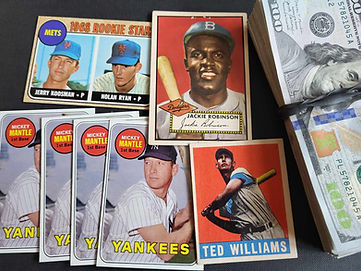
Easily Sell Your Vintage Baseball Cards For Cash: How & Where
Turn Your Vintage Sports Cards Into Cash Today In 3 Simple Steps
Throwback Sports Cards is THE PLACE to sell vintage baseball cards
Throwback Sports Cards is private collecting company specializing in buying 1900-1969 vintage sports cards. Whether it's your childhood collection, cards you inherited from a family member, or a lifetime collection, we want to hear about it! Each collection has a history, and we want to hear the story.

1
Describe Your Collection
Send us a list & pictures of the highlights of your collection. Be sure to note any complete sets,"Star" cards, rookies, and unopened boxes. Also note the years and approximate number of cards.
2
Free Appraisal & Offer
We review and catalog each card in the collection, noting condition and value. A free appraisal and fair offer is then presented to the seller.
3
Get Paid
After the offer is accepted, the seller selects their preferred payment method. This includes cash, check, Paypal, or Zelle. We strive for hassle free deals with lightning fast payments.


Contact Us
Do you have questions about the value of your baseball card collection or the selling process? Reach out today and we will get back to you as quickly as possible.
(734) 931-0461
Straight Forward Selling Process
Honest Appraisals

Top $ Paid
Lightning Fast Payment
What We Buy
Throwback Sports Cards specializes in buying 1900-1969 sports and non-sports cards including:
-
Full Collections
-
Complete Sets
-
Hall of Famers
-
Rookies
-
Topps, Bowman, Goudey, Leaf, Tobacco, & More
-
Unopened Boxes
-
Raw and Graded (PSA, SGC, BVG)
Players of Interest: Babe Ruth, Ty Cobb, Lou Gehrig, Mickey Mantle, Hank Aaron, Willie Mays, Jackie Robinson

Ways To Sell Your Cards
Schedule Appointment
Meet At Convenient Location
Ship Collection To Us
Schedule In-Home Evaluation
FAQs About Selling Your Collection
How To Prepare Your Collection To Sell
Create An Inventory List
**Not all this information is required for an appraisal. It helps give us a better idea of what you have. For more information about how to identify the brand, year, and players, click below
Check out our Price Guide and Baseball Card Database for help figuring out what you have




